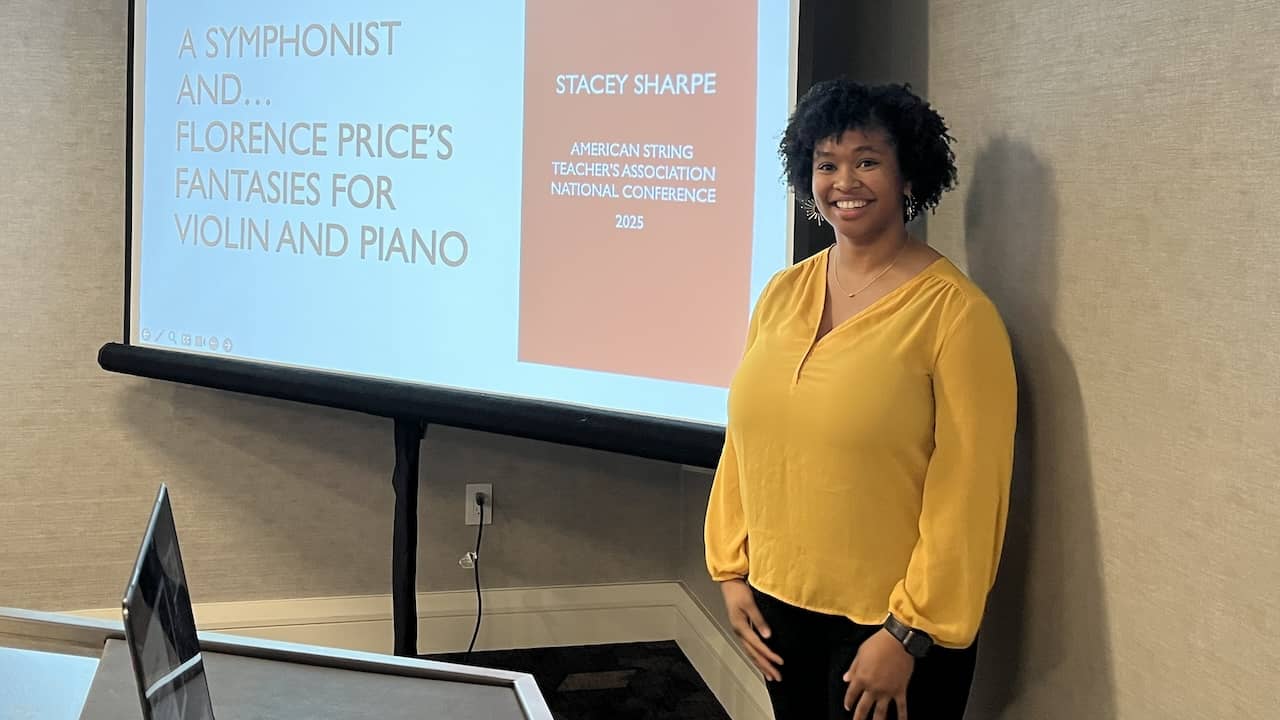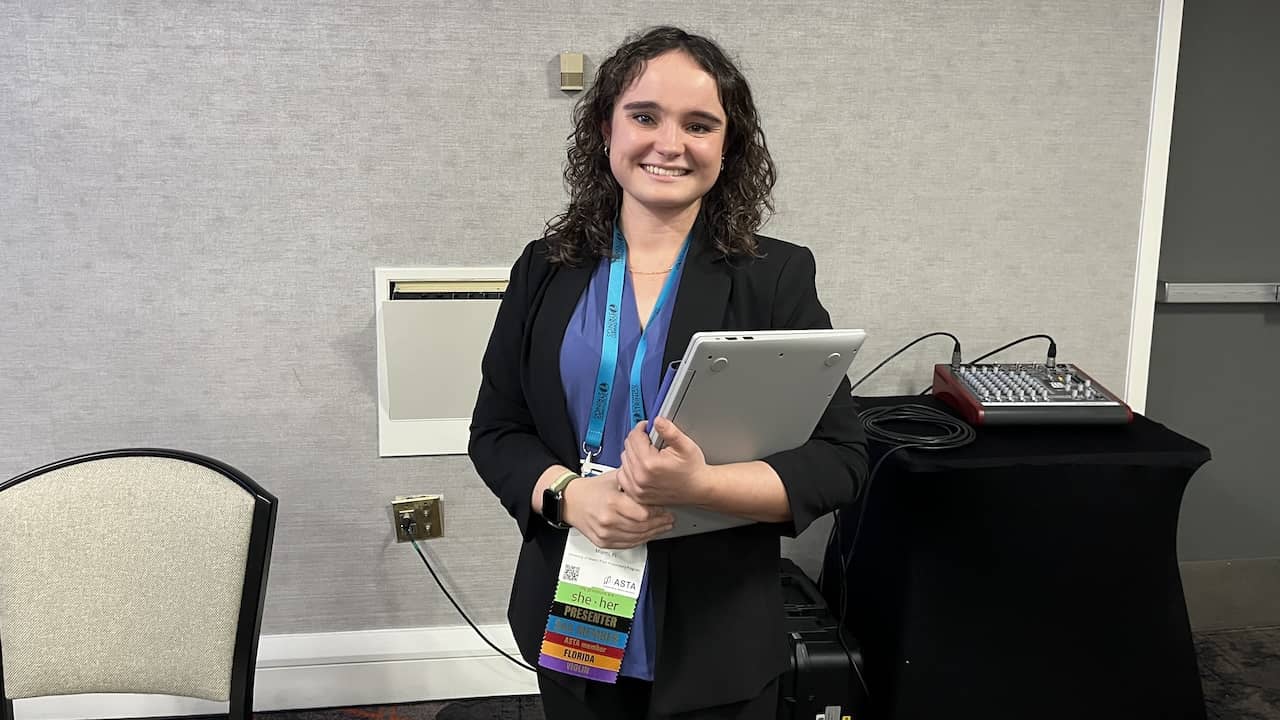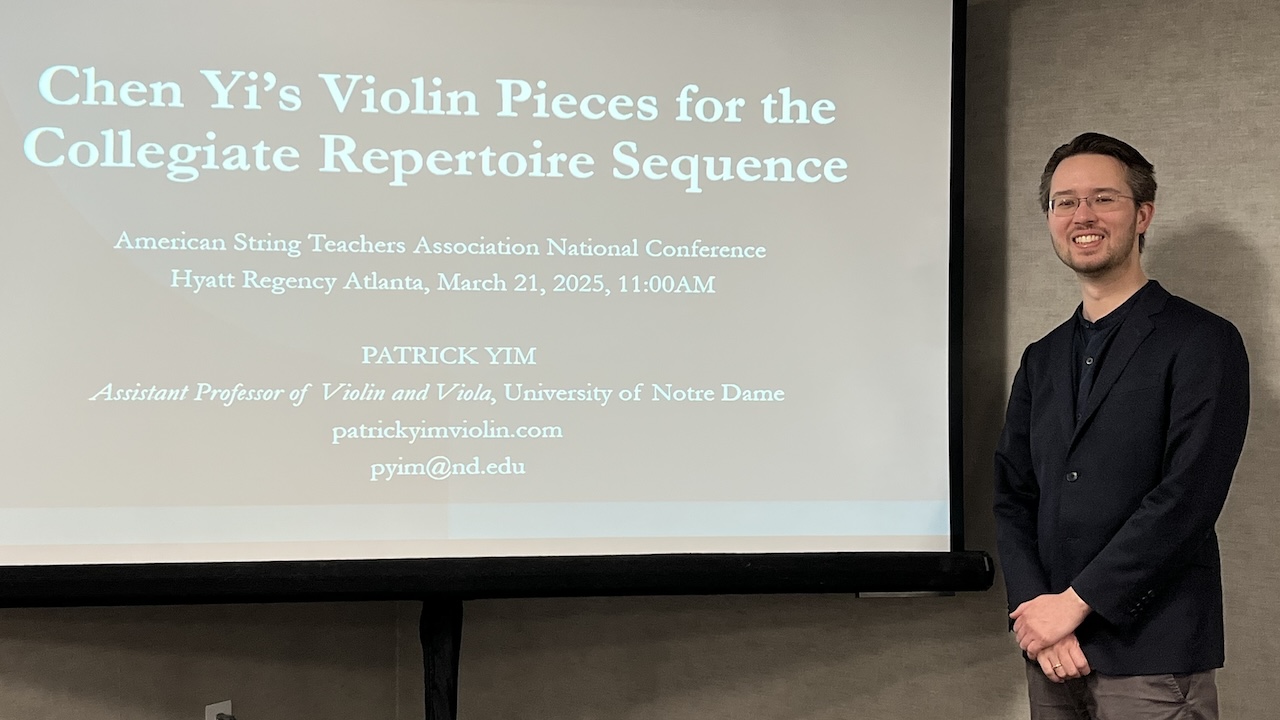ASTA 2025: Expanding the Canon - Violin Works by Women Composers
This year, the American String Teachers Association National Conference conference featured a number of fantastic presentations aimed at integrating works by female composers into the advanced repertoire, and I made sure to go to as many as I could! My own work in this area has focused primarily on pieces for beginning and intermediate students, and I was delighted to learn about pieces that I could play myself and also have in reserve for advanced students.
A Symphonist and...Florence Price's Fantasies for Violin and Piano
First up was an express talk given by Stacey Sharpe, a doctoral candidate at Florida State University, who in 20 all-too-short minutes gave us a wonderfully structured overview of Fantasie No. 1 and No. 2 by Florence Price.

Stacey Sharpe.
She started with a brief biography of Price's life and career, and highlighted that she wrote pedagogical pieces at various levels for her own students. Prices's signature style includes the use of African American idioms within a classical structure, which makes them sound instantly familiar to listeners familiar with either or both styles.
As a teacher, I really appreciated that Sharpe gave a detailed breakdown of the technical skills required to play each of the two fantasies, as well as an estimated ASTACAP (American String Teachers Association Certificate Advancement Program) level for each piece. Sharpe also featured the wonderful recordings from Randall Goosby's album Roots as examples of these two works.
Fantasie No. 1 is in G minor and requires knowledge of three-octave scales and arpeggios, some doublestops in various intervals, and requires some virtuosic flair. Sharpe places this piece at an ASTACAP Level 7. Here is the link to purchase the sheet music through Wise Music Classical: click here.
Fantasie No. 1:
Fantasie No. 2 is in F-sharp minor and is based on the spiritual tune, "I'm Workin' on My Buildin'." It features characteristics of the juba dance, a favorite of Price's (she often uses a juba instead of a scherzo in her symphonies) with syncopated rhythms. Sharpe mentioned that this piece is definitely harder than the first fantasy, featuring some fast passages in difficult hand positions, 6ths, and string crossings. Sharpe places this piece at an ASTACAP level 9/10. Here is the link to purchase the sheet music through Wise Music Classical: click here.
Fantasie No. 2:
Broader Horizons: Including Women-Composed Violin Concertos in the Collegiate Repertoire
Immediately after the session on Florence Price was another express talk given by Dr. Madison Ryan, a recent graduate of the University of Miami Frost School of Music, who presented part of her doctoral research on violin concertos by women. I was so excited to learn about these pieces!

Dr. Madison Ryan.
Ryan began the talk by discussing why we don't have as many concertos - throughout much of history, many women lacked the socio-economic power to compose large-scale pieces and lacked access to large ensembles such as orchestras. Therefore, female composers tended to write a lot of chamber music and solo works, which were easier to perform in the domestic spheres they occupied.
Ryan went on to discuss that in current collegiate repertoire, teachers tend to select historically popular concertos to teach their students as they take their place in the traditional canon. And while this is important for music students to gain experience with these classic concertos, she argued that it is equally important to give college music students a well-rounded perspective and have them also study works that are outside the standard repertoire.
For classical-era concertos, Ryan introduced us to the Six Violin Concertos, Op. 3 by Maddalena Laura Lombardini Sirmen (1745-1818). She recommended any of these concertos as an alternative or companion study to the traditionally studied classical concertos by Haydn and Mozart, and pointed out that while these use a very small ensemble, they can be easier (and less expensive) to program. Sirmen originally wrote all these pieces for her own performance and in fact gave the premieres herself. They are all in the public domain, and you can also purchase the music. Here's a link to the sheet music for Op. 3, No. 4: click here.
Next, we learned about the Violin Concerto in d minor by Swedish composer Amanda Röntgen-Maier (1853-1894), a single movement piece approximately 19 minutes long. A technically demanding piece, it includes long arpeggiated figures, doublestops, and fast scales. Ryan suggested that this would be an excellent piece to build a violinist's endurance, as there are not many opportunities for resting.
This concerto is available for purchase through Swedish Musical Heritage (click here.)
Finally, Ryan introduced us to the Violin Concerto by Ina Boyle (1889-1967), who takes us into the 20th century. Born in Ireland, Boyle studied both in Dublin and London, but spent the majority of her life after the World Wars fairly isolated in Ireland. Her concerto was composed in 1932 and 1933, but was not published until she completed revisions in 1935. It consists of three attack movements and is semi-programmatic, as it depicts the stages of grief she experienced after her mother's death.
This work is not in the public domain, but you can purchase it through the Contemporary Music Centre of Ireland. click here.
I know I can't wait to get my hands on some of these pieces and start learning them!
Chen Yi's Violin Pieces for the Collegiate Repertoire Sequence
On the second day of the conference, I was excited to attend a session on violin pieces by Chen Yi, presented by Dr. Patrick Yim, professor at Notre Dame University. (Fun fact - I attended a summer festival with Yim in 2009 and was delighted that he remembered me. I love these connections that happen at festivals, both with old acquaintances and new friends).

Dr. Patrick Yim.
I first learned about the music of Chen Yi in 2008, when she visited Baldwin-Wallace College, where I got my bachelor's degree. We had an entire week dedicated to celebrating her work and it was my first time meeting a composer. I vividly remember seeing my teacher, Dr. Julian Ross, perform her Chinese Folk Dance Suite with the orchestra and how challenging the orchestra parts were to play.
Yim began the presentation with a brief overview of Chen Yi's life and career, which includes being in the first class of students at the Central Conservatory in China, serving as concertmaster of the opera orchestra during the Cultural Revolution, being a finalist for the Pulitzer Prize, and eventually ending up in the United States, where she teaches at the University of Missouri Kansas City. Her music was described as a "cultural confluence," and Chen is equally versed in Western classical idioms as well as traditional Chinese folk music and instruments.
While this presentation focused on works for the violin as we play it, I was fascinated to learn about and hear audio samples of the traditional Chinese instruments that inspire Chen's music. Yim said that when playing or teaching these works, an understanding of the timbre is critical.
The first piece he introduced to us is the "Romance of Hsiao & Ch'in" for violin and piano. While this piece is played on what we would consider a normal violin, a hsiao is a bamboo flute, and the ch'in is a seven-string zither and the performer creates a dialogue between both.
Romance of Hsiao and Ch'in
Written alongside the Romance was the Dance, which was originally part of a fiddle suite, and was written with traditional Chinese fiddles in mind. Articulation that imitates these traditional instruments is essential for a successful performance of this piece, as is the skill of pitch-bending.
Romance & Dance: Dance
Next, Yim shared his own stunning recording of Memory, for solo violin, which has a main motif based on the Cantonese dialect and has influences from erhu and Chinese opera music. It is incredibly technically challenging, featuring lots of doublestops in more dissonant intervals such as 7ths and tritones.
Other pieces that Yim recommends exploring are the Fisherman's Song for violin and piano and the Energetic Duo for two violins.
While I don't personally have experience playing any of these pieces (though I hope to change that soon!), Yim included score and audio examples for each of them, and they all sound incredibly technically difficult. When chatting with him after, he said the Romance would be a good entry point for an advanced pre-college or college student (think early level Romantic concertos). These pieces require a high level of virtuosic technique, extended listening skills, and a knowledge of (or interest in learning about) traditional Chinese folk music and instruments. I think these pieces would make an excellent addition to a professional violinist's recital, or an extremely advanced student who is very secure in their technique.
You can purchase all of Chen Yi's pieces through Theodore Presser - click here.
Those of you familiar with my writing here on Violinist.com know that I frequently champion the works of women composers and have presented on them myself at previous conferences - I cannot adequately convey how absolutely thrilled I was to attend three presentations on works by women, and none of them were by me! I am hopeful and inspired that violinists at different stages in their careers and working with different levels of students are doing the research and sharing these pieces with the wider world so that we can all work toward a more inclusive and diverse violinistic repertoire.
You might also like:
- Exploring the Violin Works of Florence Price
- Recognizing Three Trailblazing Women Composers of the Past
- Music by Women Composers: Brian Lewis on Lyric Violin Works by Amy Beach
* * *
Enjoying Violinist.com? Click here to sign up for our free, bi-weekly email newsletter. And if you've already signed up, please invite your friends! Thank you.
Replies
Isn't it gorgeous? I need to listen several more times!
There is so much in your blog Claire that I am working my way through it in coffee breaks. Ina Boyle's concerto is new to me and I like it very much. That pastoral/meditative style is an attractive part of the cultural heritage of the British Isles. I wonder if she worked with EJ Moeran? Randall Goosby and Zhu Wan on the ROOTS album ...magnificent!
I'm intrigued by Florence Price's use of the juba dance instead of the scherzo. I've often thought that while the line-up of standard dance-based classical music forms such as the minuet, gavotte, waltz, are fine, with the opening up of the owrld, and various cultural cross-pollinations going on, it would be a pity if some of the non-European dance forms and rhythms weren't used as well.
This article has been archived and is no longer accepting comments.
Violinist.com is made possible by...
Dimitri Musafia, Master Maker of Violin and Viola Cases
International Violin Competition of Indianapolis
Johnson String Instrument/Carriage House Violins
Subscribe
Laurie's Books
Discover the best of Violinist.com in these collections of editor Laurie Niles' exclusive interviews.

Violinist.com Interviews Volume 1, with introduction by Hilary Hahn

Violinist.com Interviews Volume 2, with introduction by Rachel Barton Pine








March 25, 2025 at 09:16 PM · Wow I really love that concerto by Ina Boyle - certainly new to me!